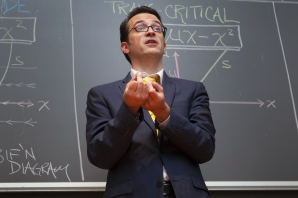
January 06, 2016
 Contributed Art/University of Pennsylvania
Contributed Art/University of Pennsylvania
Professor Robert Ghrist, Penn Integrates Knowledge Professor at the School of Arts & Sciences and the School of Engineering and Applied Science.
To many in the United States, advanced forms of mathematics are a terrifying maze of numbers, symbols, graphs, and hypotheticals that render our world more complex than simple observations would comfortably make it seem.
Those who naturally excel at math may tend to interpret such fear as an irrational perception of inferiority in the quantitative realm – whether they'll say so or not depends on the person – but one professor at the University of Pennsylvania has taken an entirely different approach to the problem altogether.
Robert Ghrist, a Penn Integrates Knowledge Professor, is leading the charge to make math more accessible through a qualitatively focused branch known as algebraic topology, Penn News reports in a new profile.
“Topology is based on the notion of proximity,” he says. “It answers questions like what’s its shape, how many holes does it have, what type of holes does it have? It’s intrinsically qualitative in nature. It’s not asking for distances between points.”
With appointments in UPenn's School of Arts and Sciences and School of Engineering and Applied Science, Ghrist is positioning topology, a form of pure mathematics, as a way to demystify complex concepts and solve certain real-world problems that other forms of math struggle to meaningfully explain.
One example is Ghrist's work in the field of neuroscience, where he and postdoc Chad Giusti are searching for better ways to interpret the massive data sets generated by the synaptic connections and firing of neurons in the brain.
Gusti recently published a paper in the Proceedings of the National Academy of Sciences that examines a computational model for developing a topology of brain network structures. The research specifically aims to articulate a way of approaching neural activity data from a conceptual rather than physical standpoint.
Giusti and other students say Ghrist is opening up a new pathway for math education that will help lead to scientific progress through contributions from those who might otherwise avoid those areas.
“He has a very different view on how math interacts with the world than many mathematicians and many scientists,” Giusti says. “He’s got a unique perspective and a whole lot of faith in the tools.”
That approach is increasingly gaining the recognition it deserves. Ghrist's online calculus class, developed as an at-your-own-pace course through Penn's Online Learning Initiative, already has more than 100,000 sign ups. He also secured a 5-year, $2.5 million grant from the Department of Defense to study how local data – for example, the layout of cell phones in pockets throughout a building – can be used to understand larger structures.
"Eventually," Ghrist said, "I want to explain applied algebraic topology to the masses. That's the future I want to see happen."
Watch below as Ghrist speaks about the relationship between engineering and math in this 2012 Engaging Minds presentation in Los Angeles.